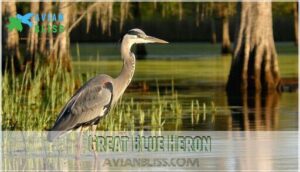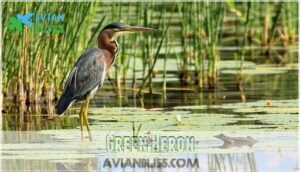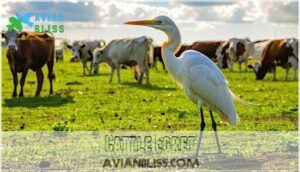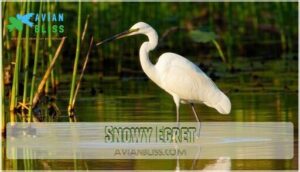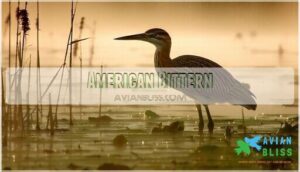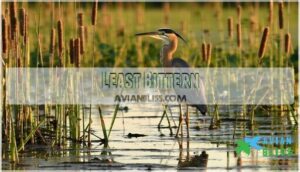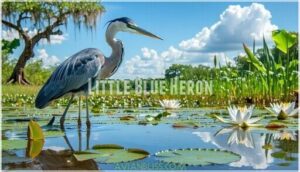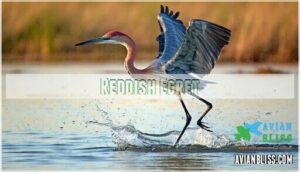This site is supported by our readers. We may earn a commission, at no cost to you, if you purchase through links.
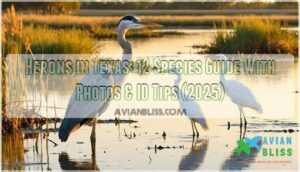
These elegant wading birds call Texas home year-round or visit during migration seasons. You can spot them in coastal marshes, swamps, ponds, and even rice fields across the state.
The Great Blue Heron stands four feet tall and hunts fish in shallow water. Snowy Egrets show off bright yellow feet, while Cattle Egrets follow livestock around pastures.
Green Herons hide along wooded streams, and the secretive American Bittern blends perfectly with cattails. Each species has unique feeding habits and preferred hangout spots that make identification easier once you know what to look for.
Table Of Contents
- Key Takeaways
- Great Blue Heron
- Black-Crowned Night Heron
- Green Heron
- Great Egret
- Cattle Egret
- Snowy Egret
- American Bittern
- Least Bittern
- Yellow-Crowned Night Heron
- Little Blue Heron
- Tricolored Heron
- Reddish Egret
- Frequently Asked Questions (FAQs)
- What is the largest heron in Texas?
- Are there any herons in Texas?
- Where do green herons live in Texas?
- Do little blue herons live in Texas?
- How many types of herons are there?
- Where do herons eat?
- Are there herons in Texas?
- Did I see a crane or a heron?
- Is there a difference between a Great Blue Heron and a blue heron?
- How to tell the difference between a sandhill crane and a blue heron?
- Conclusion
Key Takeaways
- You’ll find twelve different heron species throughout Texas, ranging from the towering 4-foot Great Blue Heron to the tiny 12-inch Least Bittern, each with unique identifying features and behaviors.
- You can distinguish herons by their feeding habits and preferred locations – Great Blue Herons hunt patiently in open water, Green Herons use tools like bait to catch fish, and Cattle Egrets follow livestock in pastures rather than staying near wetlands.
- You’ll have the best luck spotting these birds in Texas’s coastal marshes, swamps, rivers, and lakes, with some species like the Black-crowned Night-Heron being most active during twilight and evening hours.
- You can identify specific species by watching for key physical markers – Snowy Egrets have bright yellow "golden slipper" feet, Tricolored Herons display a distinctive white neck stripe, and Little Blue Herons dramatically change from white to blue as they mature.
Great Blue Heron
The Great Blue Heron stands four feet tall in Texas wetlands, making it our state’s largest wading bird.
Towering above Texas marshes, this slate-blue giant reigns as the ultimate wetland sentinel.
You’ll spot this gray-blue giant hunting fish with its dagger-like bill along coastal marshes and inland waters.
Its heron size intimidates smaller birds while its patient feeding habits involve motionless waiting before lightning-fast strikes.
These texas herons nest in colonies high in trees, building massive stick platforms.
Their heron habitat includes rivers, lakes, and estuaries throughout the state, where their adaptable heron diet and behavior guarantee survival.
They’re known to have slate-gray plumage with some chestnut accents, and are a notable example of a heron species with distinctive characteristics, including their patient feeding habits and large size.
Black-Crowned Night Heron
When twilight falls across Texas wetlands, the stocky Black-crowned Night-Heron emerges from its daytime roost to begin hunting. This medium-sized heron stands out with its distinctive black cap and back contrasting against light gray wings and white underparts.
Unlike other Texas herons, these birds exhibit strong nocturnal behavior, making them active hunters during evening hours. You’ll find these adaptable birds throughout Texas year-round, especially near the Gulf Coast.
Their global distribution makes them the world’s most widespread heron species. During breeding season, they practice colony nesting in trees near marshes, rivers, and swamps. The related yellow crowned species also favor similar wetland habitats.
Listen for their distinctive vocalizations – a harsh "quawk" when disturbed. Their diet diversity includes fish, frogs, insects, and small mammals.
Protecting heron habitat means preserving:
- Wetland ecosystems for foraging
- Roosting trees near water sources
- Clean waterways free from pollution
- Undisturbed nesting colonies
- Natural shoreline vegetation
Green Heron
Among Texas wetlands, you’ll find the Green Heron’s remarkable intelligence on full display.
This small heron uses tool use to catch fish, dropping insects as bait.
Their camouflage tactics help them blend into dense vegetation perfectly.
When startled, they make a distinctive "skeow call" that echoes across marshes.
These herons prefer shallow waters with plenty of cover for hunting.
They’re known to use bait to lure fish, demonstrating their clever hunting skills.
| Physical Features | Habitat Preferences | Diet Specifics |
|---|---|---|
| Bluish-green back | Shallow wetlands | Small fish |
| Chestnut neck | Dense vegetation | Frogs and insects |
| Compact build | Marsh edges | Aquatic invertebrates |
Great Egret
While the Green Heron skulks in shadowy creeks, you’ll spot the Great Egret standing tall in open waters like a white beacon.
This majestic texas wildlife species reaches four feet in height, making it North America’s largest white heron species. You can identify Great Egrets by their snow-white plumage, long black legs, and bright yellow bill that turns orange during breeding season.
Great Egret habitat includes marshes, lakes, and coastal wetlands throughout eastern Texas year-round. Watch their patient hunting style as they wade slowly through shallows.
Great Egret diet consists mainly of fish, frogs, and aquatic insects they spear with lightning-fast strikes. During breeding, males grow dramatic plumes called aigrettes that nearly led to their extinction in the early 1900s.
Egret conservation efforts have helped populations recover remarkably. These coastal herons nest in colonies, making them perfect subjects for bird watching enthusiasts seeking elegant heron species displays.
They’re known to have diverse foraging strategies, adapting to various habitats.
Cattle Egret
Around cattle pastures throughout Texas, you’ll discover the adaptable Cattle Egret following livestock like a feathered shadow. This compact heron species has mastered the art of opportunistic feeding, creating fascinating symbiotic relationships with grazing animals.
Unlike other Texas wildlife, Cattle Egrets don’t rely solely on wetlands for survival. Their habitat expansion into agricultural areas showcases remarkable adaptability, though their invasive status in North America raises ecological questions.
Key identification features include:
- All-white plumage with yellow-orange patches during breeding season
- Shorter, thicker neck compared to other heron species
- Stocky build, roughly crow-sized
- Yellow bill and legs that turn orange-red when breeding
- Often seen in flocks around cattle, horses, or tractors
Their dietary habits focus on insects, small reptiles, and amphibians disturbed by livestock movement. This agricultural impact benefits farmers by reducing pest populations, making Cattle Egrets welcome partners in Texas ranching operations. Perfect for bird identification and bird watching enthusiasts. They also exhibit seasonal plumage changes, with yellow-orange patches appearing during breeding season.
Snowy Egret
While cattle egrets prefer open fields, you’ll find Snowy Egrets dancing through shallow waters with unmistakable elegance. These stunning white wetland birds showcase bright yellow feet that earned them the nickname "golden slippers."
During breeding plumage season, they develop delicate feathery plumes that nearly led to their extinction in the 1800s.
Snowy Egret identification becomes easy once you spot their slender black bills and active foraging behavior. They dart through marshes, stirring up sediment with their feet to flush out prey. Their elegant white feathers are a key physical characteristic.
- Snowy diet consists mainly of fish, frogs, and aquatic insects caught through quick stabbing motions
- Habitat threats include wetland drainage and coastal development across Texas
- Conservation status remains stable thanks to protective legislation passed over a century ago
- Foraging behavior involves both patient waiting and energetic pursuit of prey
These Texas wildlife ambassadors represent successful bird identification stories and ongoing wetland conservation efforts.
American Bittern
Unlike the pristine white plumage of the Snowy Egret, you’ll find the American Bittern is a master of disguise in Texas wetlands.
This secretive bird’s brown and buff striped feathers create perfect camouflage behavior among dense marsh reeds.
You might walk right past one without knowing it’s there. The American Bittern’s secretive nature makes bird identification challenging.
When threatened, it freezes with its bill pointed skyward, becoming nearly invisible against marsh habitat vegetation. Listen for its distinctive "pump-er-lunk" call echoing across Texas wetlands – often your only clue to its presence.
This solitary heron’s bittern diet includes fish, frogs, insects, and small mammals. Standing 25-34 inches tall with a 36-52 inch wingspan, it’s smaller than most Texas herons.
While primarily a migrant, the American Bittern has confirmed breeding locations in a few Texas counties. Its conservation status remains stable, though wetland loss threatens populations.
Protecting these marsh habitats guarantees future generations can experience this remarkable example of Texas wildlife and natural heron identification challenges.
Least Bittern
While the American Bittern commands attention with its booming calls, the Least Bittern operates as nature’s master of stealth. This North America’s smallest heron proves that size doesn’t determine survival skills in Texas wetlands.
You’ll find this secretive bird incredibly challenging to spot, standing just under 12 inches tall with remarkable camouflage techniques. When threatened, it freezes with its bill pointing skyward, mimicking surrounding cattails perfectly. Its yellow eyes and black cap help with heron identification, though sightings remain rare throughout Texas.
The Least Bittern is a summer resident in the eastern half of Texas.
Habitat Specifics center on dense emergent vegetation in freshwater and brackish marshes. Feeding Habits include stalking small fish, insects, and invertebrates while moving through reeds. Vocalizations consist of quiet coo-coo-coo calls during breeding season.
Conservation Status shows declining populations due to wetland loss. Bird identification experts consider Texas wildlife sightings uncommon but significant for healthy marsh ecosystems.
- Smallest heron species in North America
- Masters stealth and camouflage in cattails
- Breeds in concealed marsh nests
- Protected under Migratory Bird Treaty Act
- Indicates healthy wetland habitat presence
Yellow-Crowned Night Heron
How do you spot Texas’s most mysterious heron after sunset? The YellowCrowned NightHeron emerges when darkness falls, showcasing striking black-and-white plumage with distinctive yellow crown feathers and thick yellow legs.
Identification Tips include their chunky build and slower hunting style compared to other Texas birds. Their Habitat Preference centers on coastal wetland habitats and inland freshwater areas.
The heron’s beak crushes shells with great efficiency. Dietary Habits focus heavily on crustaceans like crabs and crayfish.
Breeding Behavior occurs in small colonies during spring. Their Conservation Status remains stable, though birdwatching enthusiasts should respect roosting sites during your wetland visits.
Little Blue Heron
Looking for a heron that changes its outfit like a teenager trying on clothes? Meet the Little Blue Heron, a master of disguise in Texas wetlands. This medium-sized bird confuses many birdwatchers because of its dramatic Plumage Changes during Immature Stages.
Young birds start completely white, looking like egrets, then gradually turn slate-blue as adults. You’ll find these coastal birds year-round in eastern Texas, with their Habitat Specificity favoring shallow marshes and ponds.
Their patient Foraging Behavior involves slow, deliberate steps through water, hunting fish and frogs with surgical precision. During breeding season, adults develop beautiful purplish-blue neck feathers. The related tricolored heron favors similar habitats.
The Little Blue Heron’s Conservation Status remains stable, though habitat loss poses ongoing challenges. For successful birdwatching in Texas, look for their distinctive white-to-blue transformation and methodical hunting style in wetland areas.
Tricolored Heron
The Tricolored Heron (Egretta tricolor) stands out as a coastal native with unique plumage that makes identification straightforward. This New World species displays a distinctive white stripe running down its neck’s front, setting it apart from other Texas herons.
You’ll spot these elegant birds in coastal regions and shallow water habitats where they wade through estuaries and marshes. The Texas Parks and Wildlife Department reports stable populations along the Gulf Coast.
Their diet includes small fish and crustaceans, which they hunt using varied foraging techniques.
To identify the Tricolored Heron, follow these steps:
- Look for the prominent white stripe down the front of the neck
- Watch for their active hunting style—they run and stop with quick turns
- Search shallow coastal waters, lagoons, and salt marshes
- Listen for their harsh, raspy squawk calls
- Check mangrove areas and shrubs near water for nesting colonies
These medium-sized herons migrate from Mexico and Central America, arriving in February to breed through August in Texas’s coastal wetlands.
Reddish Egret
The Reddish Egret’s theatrical fishing style makes it Texas’s most entertaining coastal performer.
You’ll spot this medium-sized heron’s distinctive waggling behavior as it dances through shallow saltwater, creating quite the spectacle.
Plumage variations include a common dark morph with reddish head and neck, plus a rare all-white phase—both sporting pink bills with black tips.
| Characteristic | Dark Morph | White Morph |
|---|---|---|
| Body Color | Gray-blue | Pure white |
| Head/Neck | Reddish-brown | White with plumes |
| Bill | Pink with black tip | Pink with black tip |
| Frequency | Common | Rare |
These acrobatic hunters thrive in coastal habitats like Laguna Madre, where their mating rituals unfold from March through July.
Their conservation status remains vulnerable due to habitat loss, making heron conservation efforts essential for protecting Texas’s water habitats and supporting bird conservation initiatives.
They employ unique canopy feeding techniques to hunt effectively.
Frequently Asked Questions (FAQs)
What is the largest heron in Texas?
Standing tall like a feathered skyscraper, you’ll find the Great Blue Heron reigns as Texas’s largest heron species.
You can spot this majestic bird reaching 5 feet in height with its impressive wingspan stretching up to 201 centimeters across wetlands.
Are there any herons in Texas?
Texas hosts an impressive variety of herons.
You’ll find 11 official heron and egret species throughout the state, from the towering Great Blue Heron to smaller Green Herons, thriving in coastal marshes and inland waterways.
Where do green herons live in Texas?
Like medieval knights seeking their castle moats, you’ll find Green Herons year-round along Texas’s Gulf Coast and in Central and East Texas during breeding season.
Where they prefer wet habitats with dense vegetation.
Do little blue herons live in Texas?
Yes, you’ll find little blue herons throughout Texas.
They’re about half the size of great blue herons, with distinctive blue plumage and purplish neck feathers.
You can spot them year-round in wetlands statewide.
How many types of herons are there?
Scientists have identified around 64 heron species worldwide, like pieces in nature’s puzzle. You’ll find these wading birds across every continent except Antarctica, with Texas hosting 11 different heron and egret species.
Where do herons eat?
You’ll find herons feeding in shallow waters like marshes, lakeshores, rivers, and coastal areas.
They hunt by standing still or slowly wading, striking fish, frogs, and aquatic prey with lightning-fast precision.
Are there herons in Texas?
You’ll find eleven different heron and egret species thriving throughout Texas.
From the towering Great Blue Heron to tiny Green Herons, they’re abundant in coastal wetlands, rivers, and lakes statewide year-round.
Did I see a crane or a heron?
Spotting the difference is like solving a feathered puzzle.
You likely saw a heron if it had an S-curved neck, hunched posture, and flew with neck folded back.
Cranes fly with necks extended straight forward.
Is there a difference between a Great Blue Heron and a blue heron?
Great Blue Heron" is the official name for this specific species.
"Blue heron" is just a casual nickname people use. You’re seeing the same bird – there’s no separate species called simply "blue heron.
They’re known to have distinctive foraging behaviors while hunting in shallow waters, which exhibits their unique characteristics and distinctive methods.
How to tell the difference between a sandhill crane and a blue heron?
You’ll notice cranes are much taller with longer legs and necks.
They fly with necks extended straight out, while herons fold theirs back.
Cranes also have shorter, straighter bills compared to herons’ long, dagger-like beaks.
Great blue herons use these beaks to hunt with lightning-fast strikes.
Conclusion
Birdwatchers often compare spotting different herons in Texas to collecting trading cards – each species offers unique features that make the hunt exciting.
You’ve now learned to identify all twelve herons in Texas, from the massive Great Blue Heron to the elusive Least Bittern.
Armed with this knowledge, you can confidently explore Texas wetlands and distinguish between similar species, remembering to check feeding behaviors, size differences, and habitat preferences.
Your next birding adventure awaits in Texas’s diverse waterways.

